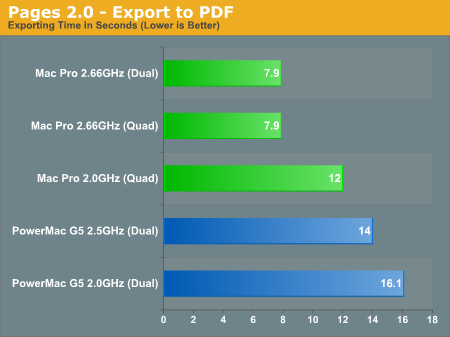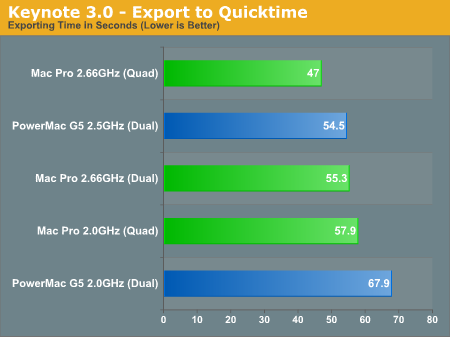Apple's Mac Pro - A True PowerMac Successor
by Anand Lal Shimpi on August 16, 2006 12:27 PM EST- Posted in
- Mac
iWork '06 Performance with Pages and Keynote
Now let's shift our attention to Apple's iWork suite, with Pages 2 and Keynote 3. For the Pages test we simply timed how long it would take to export a 116 page document to PDF. This test is single threaded.

Pretty much all of Apple's applications fare very well on the new Intel processors, and Pages is no exception. With no benefit to quad cores over dual, the Mac Pro 2.0GHz is noticeably faster than the PowerMac G5 and the 2.66GHz model simply puts it to shame.
For Keynote, there are two tests that we ran, both involving exporting a presentation. The first test exports the presentation to a PowerPoint (.ppt) file, which is a task that is pretty common for Keynote users:

Once again we see a very strong showing by the new Mac Pro. If you're looking at shaving some cost off of the system, you can always downgrade to the 2.0GHz CPU and still come out faster than a high end PowerMac G5.
The next test is exporting a smaller presentation to a Quicktime file, using the default export settings. This test is multithreaded.

Quicktime encoding seems to be a strong point of the G5 as it gives the Mac Pro a good run for its money here. A quad core PowerMac G5 could probably compete with the 2.66GHz Mac Pro in this case, although it would not be able to touch the top of the line 3GHz Mac Pro. The Mac Pro is most likely limited by a couple of factors here: 1) the additional latency and lower usable bandwidth of FB-DIMMs aren't too great for its hungry architecture, and 2) Quicktime carries very few SSEn optimizations to begin with, giving the G5 a bit of a performance advantage here.










96 Comments
View All Comments
tmohajir - Thursday, August 17, 2006 - link
I had the same question. I was debating whether to by 2 x 512MB or 1GB, and then thought it might affect performance if I went with the 1GB sticks. I think for now the best bet would be to buy 2 512s so that each branch has a channel with the same amount of memory. Then if I want to upgrade later, move all 4 512s to riser 1, and buy 2 1GB dimms when the price drops a little more and stick them in riser 2. So that way you still have 2GB total per branch.dborod - Thursday, August 17, 2006 - link
I decided to order my MacPro with 4 x 512 MB dimms so as to be able to fully utilize the available memory bandwidth. It seemed the easiest and safest approach for now.dborod - Thursday, August 17, 2006 - link
I decided to order my MacPro with 4 x 512 MB dimms so as to be able to fully utilize the available memory bandwidth. It seemed the easiest and saQuestar - Wednesday, August 16, 2006 - link
Why use MP3 encoding for performace testing in a multi cpu environment? MP3 encoding is not very threadable, and most likely is not threaded to any great extent in iTunes.Griswold - Thursday, August 17, 2006 - link
Somebody obviously has never used the multithreaded encoder of the LAME MT project. I see gains of up to 50% with that. Sure, that may not be relevant for a mac pro user, but it is proof that MP3 encoding benefits from SMT.Questar - Thursday, August 17, 2006 - link
Griswald stikes again.Yes I've heard of LAMEMT. So how's that sound quality you're getting without a bit resevoir? Pretty crappy I'll bet.
Griswold - Friday, August 18, 2006 - link
Oh give me a break nutsack. Dont pretend you know what you're talking about here, as it doesnt match your first (false) post - you obviously never used LameMT. Disabling bit reservoir may come with a certain loss of quality, but its not nearly as much as you (or the poster above) want it to make to be. I'm willing to bet 95% of the people using mp3 wont notice the difference.I'm listening to the same song encoded with standard Lame and LameMT and the quality is virtually the same. Of course, you'll now say your ears are so much better, you got so much better audio equipment and what not.. but meh, it's just questdork talking.
michael2k - Saturday, August 19, 2006 - link
The same 95% of the population who purchase tracks from the iTMS I bet :)Questar - Friday, August 18, 2006 - link
Thanks for the best laugh I've had all week!I really needed it!!
saratoga - Thursday, August 17, 2006 - link
Yeah but you also lose quality, so very few people use it.
Not exactly. LAMEMT is only multithreaded when you use parts of the MP3 standard that can be multithreaded. Typical MP3 encoding as done by lame, itunes, xing, etc simply can not be multithreaded. LAMEMT can be multithreaded because it disables certain features that are incompatable and then implements software pipelining.
The LAME devs have talked about trying to work around this problem in the past, but so far most people seem to think its just not worth the effort because the speed up is much worse then just running two copies of LAME (which gives a 100% speedup verses the 50% you saw), and of course the unresolved questions about just how badly quality would be hurt by rewriting LAME profiles from scratch to use the approach in LAMEMT.